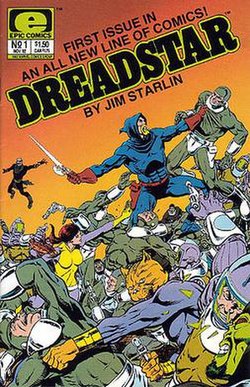Titles

- Alien Legion by writers Carl Potts and Alan Zelenetz and artist Frank Cirocco
- Atomic Age by writer Frank Lovece, penciler Mike Okamoto and inker Al Williamson
- The Black Dragon by writer Chris Claremont and artist John Bolton
- The Bozz Chronicles by writer David Michelinie and artists Bret Blevins and John Ridgway, moved to Dover Publications in 2015
- Cadillacs and Dinosaurs (colorized version) by writer-artist Mark Schultz
- Captain Confederacy (second series) by writer Will Shetterly and artist Vince Stone
- Coyote by writer Steve Englehart and artist Marshall Rogers, moved to Image Comics in 2005
- Crash Ryan by writer-artist Ron Harris
- Dreadstar by writer-artist Jim Starlin
- Dreadlands by Andy Lanning, Steve White, and Phil Gascoine
- Clive Barker's Hellraiser by various writers and artists, moved to Boom! Studios in 2011
- Clive Barker's Nightbreed by writers Alan Grant and John Wagner and artist Jim Baikie
- Clive Barker's The Harrowers by writers McNally Sagal, Malcolm Smith, Anna Miller and Fred Vicarel and artist Gene Colan
- Elfquest by writer-artists Wendy and Richard Pini
- Elektra Lives Again by writer-artist Frank Miller and colorist Lynn Varley
- Fritz Leiber's Fafhrd and the Gray Mouser by writer Howard Chaykin and artist Mike Mignola, moved to Dark Horse Comics in 2007
- Feud by writer Mike Baron and artist Mark A. Nelson
- The Groo Chronicles by writer-artist Sergio Aragonés and writer Mark Evanier
- Havok & Wolverine: Meltdown by writers Walt and Louise Simonson and artists Kent Williams and Jon J. Muth
- Interface by writer James D. Hudnall and various artists
- Iron Man: Crash by writer-artist Mike Saenz
- Lawdog by writer Chuck Dixon and artists Flint Henry,
- The Light and Darkness War by writer Tom Veitch and artist Cam Kennedy, moved to Titan Books in 2015
- Marshal Law by writer Pat Mills and artist Kevin O'Neill, moved to DC Comics in 2013
- Metropol by writer-artist Ted McKeever
- Midnight Men by writer-artist Howard Chaykin
- Moonshadow by writer J. M. DeMatteis and artists Jon J. Muth, Kent Williams and George Pratt, moved to Dark Horse Comics in 2019
- The One by writer-artist Rick Veitch, moved to King Hell Press in 2003
- Pinhead by writers D. G. Chichester and Erik Saltzgaber and artists Dario Corrasco and Phil Gascoine
- Psychonauts by writers Alan Grant and Tony Luke and artist Motofumi Kobayashi
- Sachs and Violens by writer Peter David and writer-artist George Pérez, moved to DC Comics in 2006
- Shadowline by creator Archie Goodwin
- Sisterhood of Steel by writer Christie Marx and artist Mike Vosburg
- Six From Sirius by writer by Doug Moench and artist Paul Gulacy
- The Sleeze Brothers by writer John Carnell and artist Andy Lanning
- Spyke by writer Mike Baron and artist Bill Reinhold
- Stray Toasters by writer-artist Bill Sienkiewicz
- Swords of the Swashbucklers by writer Bill Mantlo and artists Jackson Guice, Geof Isherwood and Colleen Doran
- Timespirits by writer Stephen Perry and artist Thomas Yeates
- Void Indigo by writer Steve Gerber and artist Val Mayerik
- Wild Cards by various writers and artists
Source: [2]